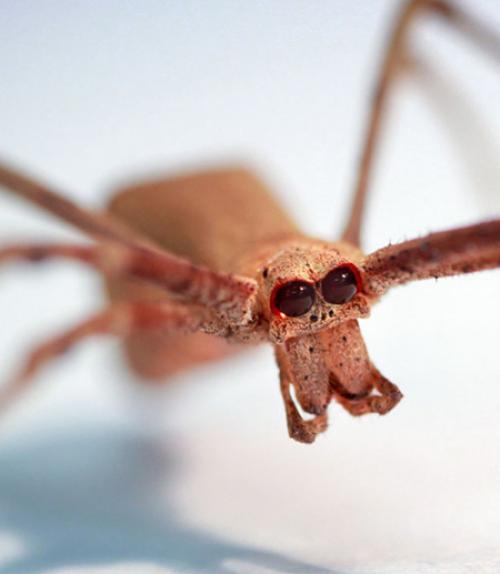In the dark of night, ogre-faced spiders with dominating big eyes dangle from a silk frame to cast a web and capture their ground prey.
But these spiders also can capture insects flying behind them with precision, and scientists have long wondered how.
Cornell scientists have confirmed that these spiders use metatarsal sensitivity – sensors at the tip of the leg – to detect sound cues at various frequencies from up to 6 feet away. These cues trigger a split-second, ninja-like backflip to strike unsuspecting airborne insects, bag them in a web net … and then dine.
This creepy-crawly research, “Ogre-Faced, Net-Casting Spiders Use Auditory Cues to Detect Airborne Prey,” appears in the journal Current Biology, Oct. 29.
“These spiders have finely tuned sensory systems and a fascinating hunting strategy,” said lead author Jay Stafstrom, a postdoctoral researcher in the laboratory of Ronald Hoy, the D & D Joslovitz Merksamer Professor in the Department of Neurobiology and Behavior in the College of Arts and Sciences.
“It’s totally unique,” Stafstrom said. “These spiders have massive eyes so they can see at night and catch things off the ground, but they can ‘hear’ quite well, detecting sound through their metatarsal organ, as these spiders excel at catching things from the air.”
Net-casting, ogre-faced spiders (Deinopis spinosa), are nocturnal creatures found mostly in the southeastern United States. While people are familiar with spiders that create orb webs, this species makes personal, fuzzy webs – like small nets – and uses the strong, sticky silk like a baseball glove, according to Hoy.
In painting a picture of the process, Hoy referenced the baseball Hall of Famer whose over-the-shoulder grab in center field in Game 1 of the 1954 World Series is the stuff of legend – simply known as “The Catch.”
“For these spiders, they’re doing a Willie Mays thing,” Hoy said. “So here comes a flying bug and somehow the spider gets information on the sound direction and its distance. The spiders time the 200-millisecond leap if the fly is within its capture zone – much like an over-the-shoulder catch. The spider gets its prey. They’re accurate.”
Spiders don’t have ears, but they can sense a wide range of sounds thanks to the metatarsal organ located near the tip of their legs. Said Stafstrom: “Their acoustic sensitivity is sufficient to trigger that backward strike behavior.”
Stafstrom collected these spiders and brought them to Hoy’s lab where Gil Menda, Ph.D. ’14, recorded neural activity from both their brains and their legs. He played pure tone frequencies to the spiders and noted the spider’s neurons became excited for different tones.
Stafstrom examined frequencies that ranged from 150 Hz (the flute-like sound of blowing over a glass soda bottle) to 750 Hz (the high-pitched drone of a local television nighttime sign-off) to 10 Khz, a piercing, high-pitched sound.
“While the spiders were sensitive to low-frequency tones, as expected,” Stafstrom said, “we didn’t really expect to see net-casting spiders sensitive to a wide range of frequencies – all the way to 10 kilohertz.”
Stafstrom’s results confirm a theory first put forth six decades ago by another Cornell researcher – Charles Walcott, Ph.D. ’59, now professor emeritus in the Department of Neurobiology and Behavior. In his doctoral thesis, through his work using oscilloscopes and other lab equipment, Walcott had put forth that a spider’s metatarsal organ was sensitive to different frequencies of sound. At the time, European scientists had ridiculed the conclusion.
But 60 years later, through Stafstrom and Hoy’s work, Walcott was proven correct. “Spiders are sensitive to airborne sound,” Walcott said. “That’s the big message really.”
In addition to Stafstrom, Hoy and Menda, the paper’s other co-authors are Eyal I. Nitzany, Ph.D. ’15, a postdoctoral researcher at Northwestern University; and Eileen A. Hebets, professor of biological sciences at the University of Nebraska.
This research was funded by the National Science Foundation.






